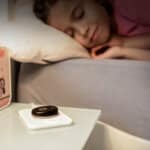Help Your Child Learn These 5 Language Skills by Going Shopping

Helping your child to build their language skills doesn’t just to happen in a clinic. You can help your child build their languags skills in almost any situation imaginable, if you know how.
For example, here are some helpful activities that you can play when you’re out shopping for groceries. We’ve grouped them by which specific language skills they’ll help develop:
- Auditory Memory: remember and recall a list or series of things.
- Inference: using a few facts to guess what will happen next.
- Vocabulary: learn more words and phrases.
- Negation: the meaning of “not.”
- Temporal: concepts related to time and sequences.
Let Your Child Hear Everything
We’ve grouped these into different areas, but that doesn’t mean you should limit their growth with specific goals. The best way to help your child grow is by making sure that they’re given as much quality exposure to sound as is possible.
Challenge them, too: letting your child hear more advanced language helps them to develop new skills instead of sticking with what they know.
Activities for Your Child
1. Auditory Memory
Here’s how you can help your child build their auditory memory, or ability to remember and recall lists or series of things.
- Before:
- Give your child a list of tasks to do before you can leave, like: “It’s time to go so please first get the grocery list off the table, put it in my purse, and then get your coat.”
- Ask your child to think of two or three things they should get at the store. Remind them to think about the items on your way to the store, and then tell you what they are once you’re at the store.
- At the store:
- As you’re shopping, hand your child some items and ask your child to put them in a certain place in the cart. For example, you could say “Put the bread by the milk, and the muffins by the carrots.”
- When you’re in the check-out line, ask your child to put a few items on the counter by saying “Can you put the carrots, bread, and cereal on the counter?”
- After:
- When you’re unpacking groceries at home, ask your child to hand you a series of items: “Please give me the cookies, cereal, and pasta.”
- Ask your child to put some items away in a specific location, like “Put the carrots and cereal in the refrigerator, and put the apples and oranges in the bowl on the table.”
2. Inference
Here’s how you can help your child use facts to guess what will happen next.
- Before:
- Ask your child questions to make them think about what they should do, like: “It’s cold outside, what should we wear to keep warm?” “It’s raining outside, so how can we stay dry?” “The store’s too far away to walk, so how can we get there?”
- Talk with your child about what types of stores sell different things, like how the toy store sells toys, grocery stores sell food, and clothes stores sell clothes. Then, ask them where you should go to buy things to eat.
- At the store:
- Explain how grocery stores are organized by different sections, like fruits and vegetables, meats, canned goods, and so on. Then, ask them where you should go to get food like carrots and apples.
- As you’re walking around, describe the characteristics of something you want to buy—but don’t say it by name. For example, say to your child that you “need to buy something that we drink, is white, and comes from a cow.” Can they find it?
- After:
- After you’ve arrived home, ask your child “why” questions: “Why did we go shopping?” “Why did we drive instead of walk?” “Why did we buy milk?”
- Describe the different ingredients you’ll use to make dinner, and ask your child if they can guess what the meal will be. For example, “We bought lettuce, carrots, celery, cucumbers, tomatoes, and dressing. What will we make?”
3. Vocabulary
Here’s how you can help your child learn about words and phrases related to shopping.
- Before:
- Make a shopping list with your child, and divide it into the different types of food. As you add items to the list, let your child know which section it should go in: “We need carrots; carrots are a vegetable so we’ll put them in the ‘produce’ section.”
- Describe to your child the different things they’ll see and use at the store, like “aisle,” “cart,” “cashier,” “groceries,” “check-out,” “shopping list,” and so on.
- At the store:
- Use the vocabulary you used when making your shopping list, like “Now we’re in the produce section, which has the fruits and vegetables. Where are the carrots?”
- Use the different store-related vocabulary like “Let’s walk down this aisle and fill our cart with some more groceries.”
- After:
- When you’re unpacking, name each of the items you pull out: “This is the milk, remember how we got it from the dairy section?”
- Describe different items and ask your child to remember their word. For example, “Do you remember the name of the thing we pushed around and put our food in?” “What kind of list did we make with all the food on it?”
4. Negation
Here’s how you can help your child to understand what “not” means.
- Before:
- As you’re making a shopping list, talk about the foods that people in your family don’t like. For example, “I like carrots, but your daddy does not like them.” “You like ice cream, but I do not.”
- Talk about the things you need to buy, and the things you don’t: “We need to buy milk, but we do not need to buy oranges. That’s because we already have enough oranges.”
- At the store:
- As you’re walking through the store, describe characteristics of different food: “Apples are read, but bananas are not. Bananas are yellow.” “The milk is cold, but the bread is not cold. The bread is warm.” “The soup is in a can, but the cereal is not in a can.”
- In a given aisle, talk about what’s in it and what is not: “We are in the produce section, so there are apples here but there are not eggs.”
- After:
- When unpacking, tell your child where specific items do or don’t go: “The milk goes in the refrigerator, but the cereal does not.” “The soup goes in the cupboard, but the carrots go in the refrigerator.”
- Explain that some foods can be eaten as-is, while others need preparation: “We can eat the carrots without doing anything, but we cannot eat the soup without warming it up.” “We can eat the bread like this, but we cannot just eat the potatoes.”
5. Temporal
Here’s how you can help your child to understand time: sequences, “before” and “after,” and more.
- Before:
- Talk about what will happen, in the order it will happen: “First we will make the shopping list, then second we will go to the store, then third we will pick out the food and pay for it, then finally we’ll come back home.”
- Say what you need to do before or after another thing: “Before we go to the store, we have to make a shopping list.” “After we buy the groceries, we will come home.”
- At the store:
- Talk about what you need to do before doing something else, with the word “until” For example, “We won’t leave the produce section until we’ve gotten all the fruits and vegetables.” “We won’t pay for our groceries until we’ve gotten everything on the list.”
- Use “before” and “after” again: “Before we get our milk, we will need to get the vegetables.” “After we’ve gotten our milk, we’ll go get the bread.”
- After:
- Use the word “while” to talk about what happened. “While we were at the store, we talked to the man at the meat counter.” “We got lots of food while we were at the store!”
- Use the different times of day, like “morning,” “afternoon,” and “evening.” For example, “We left to the store in the morning, and it was afternoon by the time we got back.” “We’ll use the groceries to make dinner this evening.”
These are just a few of the different ways you can turn a routine activity into a learning experience for your child.
Is there another activity you’d like us to turn into a learning experience for language skills? Let us know in a comment below!
This post was written by MaryKay Therres, a speech-language pathologist and Rehabilitation Specialist at MED-EL.
SUBSCRIBE to the MED-EL blog to get lots more tips like these to help you or your child build language, listening, or thinking skills—and more!
Thanks for your message. We will reply as soon as possible.
Send us a message
Field is required
John Doe
Field is required
name@mail.com
Field is required
What do you think?


